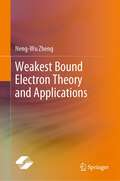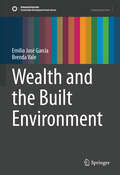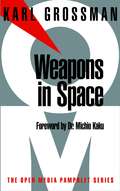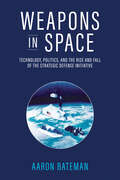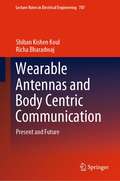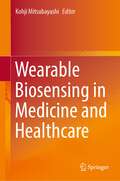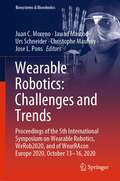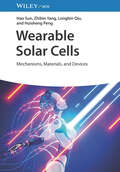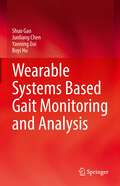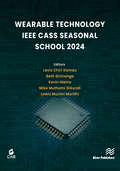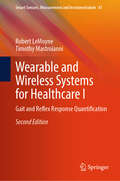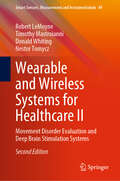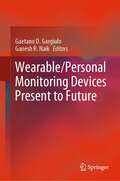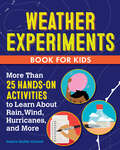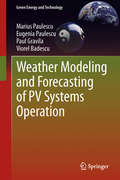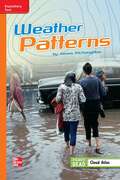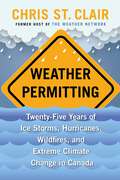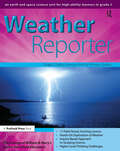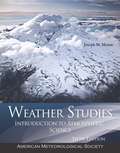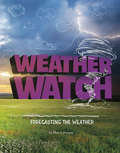- Table View
- List View
Weakest Bound Electron Theory and Applications
by Neng-Wu ZhengThis monograph describes the new quantum theory called the weakest bound electron theory (WBE theory) proposed by Prof. Neng-Wu Zheng and its applications. It starts with the fundamentals of quantum mechanics and then illustrates the key points of WBE theory and the mathematical expressions of WBE theory. Finally, it presents a wide range of applications of WBE theory to the chemical and physical properties of atoms and molecules, including energy levels, transition properties, the difference law of ionization energies etc. It appeals to a broad readership, particularly researchers and academics in chemistry, physics, and materials science.
Wealth and the Built Environment (Sustainable Development Goals Series)
by Brenda Vale Emilio José GarcíaThe need to address global environmental problems is urgent. The United Nations 17 Sustainable Development Goals (SDGs) cover a wide range of global concerns, from poverty, hunger, and gender equity to justice and climate action. Concerningly, the SDGs still have faith in economic growth and technological innovation as the means of fixing all global concerns, including climate change. What is not questioned is whether solving development and sustainability problems through economic growth for the accumulation of wealth for the few has led to many of the current unequal development and environmental problems. If unfair growth and wealth accumulation have been part of the problem, how can they be part of the solution? The problem with the SDGs is that their fulfilment relies on wealth creation without the fundamental concomitant of wealth redistribution. The one common driver of change affecting both sustainability and development that has not been included in the SDGs is wealth, the central focus of this book. SDG 11 – sustainable cities and communities – presents a further paradox unless the issue of wealth and its fair distribution is grasped. Cities are the places where wealth is generated but are also places where only a minority are wealthy. The wealth generated in cities leads to higher consumption of resources, higher emissions, and higher disparities and inequalities. However, any version of a sustainable future will happen in the built environment made according to current ideals, like the present belief in overcoming all humanity's problems by becoming wealthier. A fundamental assumption of this book is that the first step toward a fairer habitat that can maintained with the resources available is only possible if we stop designing cities and buildings as if everyone were wealthy or had to become wealthy. To achieve this goal, it is essential to identify and raise awareness of the impact of wealth, to question how the myths about the advantages of wealth were built, where they come from, what shape they take in the built environment and who benefits from them.
Weapons in Space (Open Media Series)
by Michio Kaku Karl GrossmanWeapons in Space examines how the United States is forcing forward--in violation of international treaties--to militarize space. Based on excerpts from U.S. government documents, award-winning investigative journalist Karl Grossman outlines the U.S. military's space doctrine, its similarity with the original Stars Wars scheme of Ronald Reagan and Edward Teller, and the space-based lasers, hypervelocity guns, and particle beams it plans to deploy in its mission to "dominate" earth.Grossman shows the intimate link between the militarization and the nuclearization of space, and follows the flow of billions of U.S. tax dollars to the corporations that research and develop weapons for space. His book explains the Outer Space Treaty and gives a history of the Global Network Against Weapons and Nuclear power in Space: what it is doing, what it plans to do--and what the reader can do to challenge U.S. plans to turn the heavens into a war zone.
Weapons in Space: Technology, Politics, and the Rise and Fall of the Strategic Defense Initiative
by Aaron BatemanA new and provocative take on the formerly classified history of accelerating superpower military competition in space in the late Cold War and beyond.In March 1983, President Ronald Reagan shocked the world when he established the Strategic Defense Initiative (SDI), derisively known as &“Star Wars,&” a space-based missile defense program that aimed to protect the US from nuclear attack. In Weapons in Space, Aaron Bateman draws from recently declassified American, European, and Soviet documents to give an insightful account of SDI, situating it within a new phase in the militarization of space after the superpower détente fell apart in the 1970s. In doing so, Bateman reveals the largely secret role of military space technologies in late–Cold War US defense strategy and foreign relations.In contrast to existing narratives, Weapons in Space shows how tension over the role of military space technologies in American statecraft was a central source of SDI&’s controversy, even more so than questions of technical feasibility. By detailing the participation of Western European countries in SDI research and development, Bateman reframes space militarization in the 1970s and 1980s as an international phenomenon. He further reveals that even though SDI did not come to fruition, it obstructed diplomatic efforts to create new arms control limits in space. Consequently, Weapons in Space carries the legacy of SDI into the post–Cold War era and shows how this controversial program continues to shape the global discourse about instability in space—and the growing anxieties about a twenty-first-century space arms race.
Wearable Antennas and Body Centric Communication: Present and Future (Lecture Notes in Electrical Engineering #787)
by Shiban Kishen Koul Richa BharadwajThis book presents state-of-the-art technologies, trends and applications with a focus on the healthcare domain for ultra-wideband (3.1–10.6 GHz) and 60 GHz (57–66 GHz) wireless communication systems. Due to various key features such as miniaturized antenna design, low power, high data rate, less effects on the human body, relatively less crowded spectrum, these technologies are becoming popular in various fields of biomedical applications and day-to-day life. The book highlights various aspects of these technologies related to body-centric communication, including antenna design requirements, channel modeling and characterization for WBANs, current fabrication and antenna design strategies for textile, flexible and implanted antennas. Apart from the general requirements and study related to these frequency bands, various application specific topics such as localization and tracking, physical activity recognition and assessment, vital sign monitoring and medical imaging are covered in detail. The book concludes with the glimpses of future aspects of the UWB and 60 GHz technology which includes IoT for healthcare and smart living, novel antenna materials and application of machine learning algorithms for overall performance enhancement.
Wearable Biosensing in Medicine and Healthcare
by Kohji MitsubayashiThis book contains chapters on wearable biomedical sensors and their assistive technologies for promoting behavioral change in medical and health care. Part I reviews several wearable biomedical sensors based on biocompatible materials and nano and micro-electromechanical systems (MEMS) technologies in the medical and dental fields. Part II introduces the latest approaches to wearable biosensing using unique devices for various skin targets such as sweat, interstitial fluid, and transcutaneous gases. Part III presents technologies supporting wearable sensors, including soft and flexible materials, manufacturing methods, skin volatile-marker imaging, and energy harvesting devices.This book is intended for graduate students, academic researchers, and professors that work in medical and healthcare research fields, as well as industry professionals involved in the development of wearable and flexible sensing devices and measurement systems for human bio/chemical sensing, medical monitoring, and healthcare services, and for medical professionals and government officials who are driving behavior change in health care.
Wearable Robotics: Proceedings of the 5th International Symposium on Wearable Robotics, WeRob2020, and of WearRAcon Europe 2020, October 13–16, 2020 (Biosystems & Biorobotics #27)
by Juan C. Moreno Jawad Masood Urs Schneider Christophe Maufroy Jose L. PonsThis book reports on advanced topics in the areas of wearable robotics research and practice. It focuses on new technologies, including neural interfaces, soft wearable robots, sensors and actuators technologies, discussing industrially and medically-relevant issues, as well as legal and ethical aspects. It covers exemplary case studies highlighting challenges related to the implementation of wearable robots for different purposes, and describing advanced solutions. Based on the 5th International Symposium on Wearable Robotics, WeRob2020, and on WearRacon Europe 2020, which were both held online on October 13-16, 2020, the book addresses a large audience of academics and professionals working in for the government, in the industry, and in medical centers, as well as end-users alike. By merging together engineering, medical, ethical and industrial perspectives, it offers a multidisciplinary, timely snapshot of the field of wearable technologies.
Wearable Solar Cells: Mechanisms, Materials, and Devices
by Huisheng Peng Hao Sun Zhibin Yang Longbin QiuWearable Solar Cells Understand a groundbreaking new energy technology Solar energy is one of the most important paths to a sustainable future. In recent years, extensive research and development has begun to produce wearable solar cells, whose novel planar and fiber format gives them enormous flexibility and a wide range of potential uses. The possibility of a solar energy source that can be fitted to the human body promises to become an extraordinary tool for meeting various kinds of personal energy needs. Wearable Solar Cells: Mechanisms, Materials, and Devices serves as a comprehensive introduction to this cutting-edge technology and its applications. Recent research pointing towards fiber-format solar cells as a bold new frontier is summarized and explored. The result is an essential resource for both experienced researchers and newcomers to the field. Wearable Solar Cells readers will also find: Close coverage of integrated energy harvesting and storage devices Detailed discussion of dye-sensitized solar cells, polymer solar cells, perovskite solar cells, and more An authorial team with decades of combined research experience Wearable Solar Cells is ideal for materials scientists, polymer chemists, electrical engineers, solid-state physicists, and advanced students interested in these and related topics.
Wearable Systems Based Gait Monitoring and Analysis
by Shuo Gao Junliang Chen Yanning Dai Boyi HuWearable Systems Based Gait Monitoring and Analysis provides a thorough overview of wearable gait monitoring techniques and their use in health analysis. The text starts with an examination of the relationship between the human body’s physical condition and gait, and then introduces and explains nine mainstream sensing mechanisms, including piezoresistive, resistive, capacitive, piezoelectric, inductive, optical, air pressure, EMG and IMU-based architectures. Gait sensor design considerations in terms of geometry and deployment are also introduced. Diverse processing algorithms for manipulating sensors outputs to transform raw data to understandable gait features are discussed. Furthermore, gait analysis-based health monitoring demonstrations are given at the end of this book, including both medical and occupational applications. The book will enable students of biomedical engineering, electrical engineering, signal processing, and ergonomics and practitioners to understand the medical and occupational applications of engineering-based gait analysis and falling injury prevention methods.
Wearable Technology: IEEE CASS Seasonal School 2024
by Levis Chiri Kamau Beth Gichanga Kevin Maina Mike Muthomi Gikundi Lewis Murimi MurithiThis book is the result of a groundbreaking milestone CASS seasonal school dedicated to Wearable Technology that was held for the first time in Africa. It is a reference on the evolving terrain of wearable tech and circuit-based technologies in specific fields including data processing and signal analysis, enhancing patient monitoring, and improving quality of life for senior adults. It also covers broad topics such as trends in wearable technology and the art of circuit design.The seasonal school provided exclusive opportunities for attendees to interact with renowned experts across multiple domains. Participants gained invaluable insights into the forefront of innovation, equipping them with the knowledge and skills necessary to thrive in this rapidly evolving field. The school brought forward real-world examples as well as the latest global advancements in wearable technology. Facilitating direct engagement with leading experts in the field and fostering networking opportunities, the school served as a center for knowledge exchange and professional growth.
Wearable and Wireless Systems for Healthcare I: Gait and Reflex Response Quantification (Smart Sensors, Measurement and Instrumentation #47)
by Timothy Mastroianni Robert LeMoyneThis book is the second edition of the one originally published in 2017. The original publication features the discovery of numerous novel applications for the use of smartphones and portable media devices for the quantification of gait, reflex response, and an assortment of other concepts that constitute first-in-the-world applications for these devices. Since the first edition, numerous evolutions involving the domain of wearable and wireless systems for healthcare have transpired warranting the publication of the second edition. This volume covers wearable and wireless systems for healthcare that are far more oriented to the unique requirements of the biomedical domain. The paradigm-shifting new wearables have been successfully applied to gait analysis, homebound therapy, and quantifiable exercise. Additionally, the confluence of wearable and wireless systems for healthcare with deep learning and neuromorphic applications for classification is addressed. The authors expect that these significant developments make this book valuable for all readers.
Wearable and Wireless Systems for Healthcare II: Movement Disorder Evaluation and Deep Brain Stimulation Systems (Smart Sensors, Measurement and Instrumentation #49)
by Timothy Mastroianni Robert LeMoyne Donald Whiting Nestor TomyczThis book is the second edition of the one originally published in 2019. The original publication features the discovery of numerous novel applications for the use of smartphones and portable media devices for the quantification of deep brain stimulation for the treatment of movement disorders that constitute first-in-the-world applications for these devices. Since the first edition, numerous evolutions involving the domain of wearable and wireless systems for healthcare and deep brain stimulation have transpired warranting the publication of the second edition. This volume covers wearable and wireless systems for healthcare that are far more relevant to the unique requirements of the domain of deep brain stimulation. The paradigm-shifting new wearables comprising attributes of conformability and further miniaturization have been recently applied for the context of deep brain stimulation. Additionally, the subjects of automated optimization for deep brain stimulation and the rampantly expanding additional applications for deep brain stimulation are addressed. The authors expect that these significant developments make this book valuable for all readers.
Wearable/Personal Monitoring Devices Present to Future
by Ganesh R. Naik Gaetano D. GargiuloThis book discusses recent advances in wearable technologies and personal monitoring devices, covering topics such as skin contact-based wearables (electrodes), non-contact wearables, the Internet of things (IoT), and signal processing for wearable devices. Although it chiefly focuses on wearable devices and provides comprehensive descriptions of all the core principles of personal monitoring devices, the book also features a section on devices that are embedded in smart appliances/furniture, e.g. chairs, which, despite their limitations, have taken the concept of unobtrusiveness to the next level. Wearable and personal devices are the key to precision medicine, and the medical community is finally exploring the opportunities offered by long-term monitoring of physiological parameters that are collected during day-to-day life without the bias imposed by the clinical environment. Such data offers a prime view of individuals’ physical condition, as well as the efficacy of therapy and occurrence of events. Offering an in-depth analysis of the latest advances in smart and pervasive wearable devices, particularly those that are unobtrusive and invisible, and addressing topics not covered elsewhere, the book will appeal to medical practitioners and engineers alike.
Weather Experiments Book for Kids: More Than 25 Hands-On Activities to Learn about Rain, Wind, Hurricanes, and More
by Jessica Stoller-ConradHelp kids ages 8 to 12 experiment like scientists and discover the world of weather! What makes the weather change? What happens in the sky when storm clouds form? The Weather Experiments Book for Kids does more than just explain how weather events work—it lets kids see weather in action! Discover 25 fun experiments kids can create right at home, and explore fascinating weather like rain, clouds, tornadoes, and more! What's weather, anyway?—Kids will get a quick introduction to the difference between weather, climate, and atmosphere, and all the factors that affect what it looks like outside each day. Get hands-on—Kids will make their own barometer that measures atmospheric pressure, create clouds with water and hairspray, test soil conditions, and more. Independent learning—These experiments are designed with easy instructions and materials so kids can do them with minimal help from adults. Discover more than other weather books for kids with experiments that make weather come to life!
Weather Modeling and Forecasting of PV Systems Operation
by Viorel Badescu Eugenia Paulescu Paul Gravila Marius PaulescuIn the past decade, there has been a substantial increase of grid-feeding photovoltaic applications, thus raising the importance of solar electricity in the energy mix. This trend is expected to continue and may even increase. Apart from the high initial investment cost, the fluctuating nature of the solar resource raises particular insertion problems in electrical networks. Proper grid managing demands short- and long-time forecasting of solar power plant output. Weather modeling and forecasting of PV systems operation is focused on this issue. Models for predicting the state of the sky, nowcasting solar irradiance and forecasting solar irradiation are studied and exemplified. Statistical as well as artificial intelligence methods are described. The efficiency of photovoltaic converters is assessed for any weather conditions. Weather modeling and forecasting of PV systems operation is written for researchers, engineers, physicists and students interested in PV systems design and utilization.
Weather Patterns: Severe Storms in Galetown, Investigation Notebook with Article Compilation
by The Lawrence Hall of ScienceNIMAC-sourced textbook
Weather Permitting: Twenty-Five Years of Ice Storms, Hurricanes, Wildfires, and Extreme Climate Change in Canada
by Chris St. ClairFrom the longtime host of The Weather Network comes a behind-the-scenes look at Canada&’s biggest weather events and climate phenomena.For more than twenty-five years, Chris St. Clair was on the frontline of Canada&’s biggest weather events as a popular presenter on The Weather Network. For the first time, he shares his never-before-told stories covering the country&’s most astounding weather events. From the flooding of the Red River in Winnipeg to the ice storm in Montreal, the hurricanes in Newfoundland, the devastating wildfires in Fort McMurray, the hailstorm in Calgary, and the heat dome and horrifying floods in British Columbia, St. Clair recalls these extreme weather events and relays their impact on communities across the country. He also follows Canadian snowbirds south to Florida and recounts their dramatic escape from record-breaking Hurricanes Matthew and Irma. A vivid personal narrative with accessible scientific explanations and meteorological analysis, Weather Permitting tells the story of how the weather has shaped the character and psyche of our nation, and is an homage to the strength and resilience of Canadian communities from coast to coast.
Weather Reporter: An Earth and Space Science Unit for High-Ability Learners in Grade 2
by Clg Of William And Mary/Ctr Gift EdWeather Reporter, a second-grade Earth and space science unit, provides students with opportunities in a scenario-based approach to observe, measure, and analyze weather phenomena. The overarching concept of change reinforces students' decisions as they learn about the changes in the Earth's weather and observe, measure, and forecast the weather.Weather Reporter was developed by the Center for Gifted Education at The College of William and Mary to offer advanced curriculum supported by years of research. The Center's materials have received national recognition from the United States Department of Education and the National Association for Gifted Children, and they are widely used both nationally and internationally.Each of the books in this series offers curriculum that focuses on advanced content and higher level processes. The science units contain simulations of real-world problems, and students experience the work of real science by using data-handling skills, analyzing information, and evaluating results. The mathematics units provide sophisticated ideas and concepts, challenging extensions, higher order thinking skills, and opportunities for student exploration based on interest. These materials are a must for any teacher seeking to challenge and engage learners and increase achievement.Grade 2
Weather Services for the Nation: Becoming Second to None
by Committee on the Assessment of the National Weather Service's Modernization ProgramDuring the 1980s and 1990s, the National Weather Service (NWS) undertook a major program called the Modernization and Associated Restructuring (MAR). The MAR was officially completed in 2000. No comprehensive assessment of the execution of the MAR plan, or comparison of the promised benefits of the MAR to its actual impact, had ever been conducted. Therefore, Congress asked the National Academy of Sciences to conduct an end-to-end assessment. That report, The National Weather Service Modernization and Associated Restructuring: A Retrospective Assessment, concluded that the MAR was a success. Now, twelve years after the official completion of the MAR, the challenges faced by the NWS are no less important than those of the pre-MAR era. The three key challenges are: 1) Keeping Pace with accelerating scientific and technological advancement, 2) Meeting Expanding and Evolving User Needs in an increasingly information centric society, and 3) Partnering with an Increasingly Capable Enterprise that has grown considerably since the time of the MAR. Weather Services for the Nation presents three main recommendations for responding to these challenges. These recommendations will help the NWS address these challenges, making it more agile and effective. This will put it on a path to becoming second to none at integrating advances in science and technology into its operations and at meeting user needs, leading in some areas and keeping pace in others. It will have the highest quality core capabilities among national weather services. It will have a more agile organizational structure and workforce that allow it to directly or indirectly reach more end-users, save more lives, and help more businesses. And it will have leveraged these capabilities through the broader enterprise. This approach will make possible societal benefits beyond what the NWS budget alone allows.
Weather Studies: Introduction to Atmospheric Science (Fifth Edition)
by Joseph M. Moran"The American Meteorological Society (AMS), founded in 1919, is a scientific and professional society. Interdisciplinary in its scope, the Society actively promotes the development and dissemination of information on the atmospheric and related oceanic and hydrologic sciences. AMS has more than 14,000 professional members from more than 100 countries and over 175 corporate and institutional members representing 40 countries. The Education Program is the initiative of the American Meteorological Society fostering the teaching of the atmospheric and related oceanic and hydrologic sciences at the precollege level and in community college, college and university programs. It is a unique partnership between scientists and educators at all levels with the ultimate goals of (1) attracting young people to further studies in science, mathematics and technology, and (2) promoting public scientific literacy. This is done via the development and dissemination of scientifically authentic, up-to-date, and instructionally sound learning and resource materials for teachers and students. AMS Weather Studies, a component of the AMS education initiative since 1999, is an introductory undergraduate meteorology course offered partially via the Internet in partnership with college and university faculty. AMS Weather Studies provides students with a comprehensive study of the principles of meteorology while simultaneously providing classroom and laboratory applications focused on current weather situations. It provides real experiences demonstrating the value of computers and electronic access to time-sensitive data and information. "
Weather Watch: Forecasting the Weather (Weather and Climate)
by Ellen LabrecqueWeather affects us every day. How do we know what the weather will be like where we live? How can we prepare for it? Find out the science behind weather observation and prediction.
